#asia pacific 2022
Explore tagged Tumblr posts
Text

The Regime World Tour 2022: Asia-Pacific Jakarta | Tennis Indoor Senayan Tuesday December 6, 2022 | RegimeTour.com
Location
Tennis Indoor Senayan -6.219378052404909, 106.80047575443915, Jakarta, 10270, Indonesia Tel: 0215734070 Web: http://gbk.id Show on map
DPR WE GANG GANG!!🙌
We are excited to announce that @dpr_official will hold THE REGIME WORLD TOUR LIVE IN JAKARTA on December 6th 2022 at Tennis Indoor Senayan!
INDONESIA, Y'ALL BETTER GET PREPARED TO CATCH @dprian @dprlive @dprcream LIVE!
🎫Be the first to check into regimetour.com on this August 12th 11:00 WIB to grab your tickets for The Regime World Tour Live in Jakarta!
More deets coming soon!
This show is proudly promoted by @ckstar.id and @soundrhythm
#TheRegimeTourIndonesia #TheRegimeTourJakartaEvent added by ZeGrave
#2022#regime tour 2022#tour dates 2022#asia pacific 2022#christian yu#dpr#dpr ian#dream perfect regime#jakarta#Jakarta 2022#indonesia#Indonesia 2022#regime tour asia pacific#regime tour jakarta#tour dates
2 notes
·
View notes
Text
Self-Powered Relays Market Overview and Regional Outlook Study 2023 – 2032

Details
Market Size by 2032
USD 31.98 Billion
Growth Rate from 2023 to 2032
CAGR of 5.78%
Largest Market
Asia Pacific
Base Year
2022
The market for self-powered relays has been growing steadily due to several factors. One of the key drivers is the increasing demand for energy-efficient solutions in various industries. Self-powered relays eliminate the need for external power sources, thereby reducing energy consumption and improving overall efficiency.
Furthermore, the growing emphasis on renewable energy sources, such as solar and wind power, has created a need for reliable and efficient relays in power generation and distribution systems. Self-powered relays are well-suited for these applications as they can operate in remote locations and do not rely on external power sources, making them ideal for use in renewable energy infrastructure.
The rise of smart grids and the increasing adoption of automation and control systems in various industries are also driving the demand for self-powered relays. These relays play a crucial role in protecting electrical systems, detecting faults, and ensuring safe and efficient operation.
Overall, the global self-powered relays market is experiencing growth driven by factors such as energy efficiency requirements, renewable energy integration, and the adoption of smart grid technologies.
I recommend referring to our Stringent datalytics firm, industry publications, and websites that specialize in providing market reports. These sources often offer comprehensive analysis, market trends, growth forecasts, competitive landscape, and other valuable insights into the humidity sensors market.
By visiting our website or contacting us directly, you can explore the availability of specific reports related to the humidity sensors market. These reports often require a purchase or subscription, but we provide comprehensive and in-depth information that can be valuable for businesses, investors, and individuals interested in the market.
“Remember to look for recent reports to ensure you have the most current and relevant information.”
Click Here, To Get Free Sample Report https://stringentdatalytics.com/sample-request/self-powered-relays-market/1200/
Market Segmentations:
Global Self-Powered Relays Market: By Company • ABB • Siemens • Fanox • Schneider Electric • Eaton • C&S Electric • JVS Electronics • Ashida Electronics • Relko Enerji • Kries-Energietechnik Global Self-Powered Relays Market: By Type • Static • Numerical • Auxiliary Global Self-Powered Relays Market: By Application • Power Generation • Utilities • Infrastructure • Industrial • Transportation • Others Global Self-Powered Relays Market: Regional Analysis All the regional segmentation has been studied based on recent and future trends, and the market is forecasted throughout the prediction period. The countries covered in the regional analysis of the Global Self-Powered Relays market report are U.S., Canada, and Mexico in North America, Germany, France, U.K., Russia, Italy, Spain, Turkey, Netherlands, Switzerland, Belgium, and Rest of Europe in Europe, Singapore, Malaysia, Australia, Thailand, Indonesia, Philippines, China, Japan, India, South Korea, Rest of Asia-Pacific (APAC) in the Asia-Pacific (APAC), Saudi Arabia, U.A.E, South Africa, Egypt, Israel, Rest of Middle East and Africa (MEA) as a part of Middle East and Africa (MEA), and Argentina, Brazil, and Rest of South America as part of South America.
Visit Report Page for More Details: https://stringentdatalytics.com/reports/self-powered-relays-market/1200/
Reasons to Purchase Self-Powered Relays Market Report:
• To obtain insights into industry trends and dynamics, including market size, growth rates, and important factors and difficulties. This study offers insightful information on these topics.
• To identify important participants and rivals: This research studies can assist companies in identifying key participants and rivals in their sector, along with their market share, business plans, and strengths and weaknesses.
• To comprehend consumer behaviour: these research studies can offer insightful information about customer behaviour, including preferences, spending patterns, and demographics.
• To assess market opportunities: These research studies can aid companies in assessing market chances, such as prospective new goods or services, fresh markets, and new trends.
• To make well-informed business decisions: These research reports give companies data-driven insights that they may use to plan their strategy, develop new products, and devise marketing and advertising plans.
In general, market research studies offer companies and organization’s useful data that can aid in making decisions and maintaining competitiveness in their industry. They can offer a strong basis for decision-making, strategy development, and business planning.
Click Here, To Buy Premium Report: https://stringentdatalytics.com/purchase/self-powered-relays-market/1200/?license=single
About US:
Stringent Datalytics offers both custom and syndicated market research reports. Custom market research reports are tailored to a specific client's needs and requirements. These reports provide unique insights into a particular industry or market segment and can help businesses make informed decisions about their strategies and operations.
Syndicated market research reports, on the other hand, are pre-existing reports that are available for purchase by multiple clients. These reports are often produced on a regular basis, such as annually or quarterly, and cover a broad range of industries and market segments. Syndicated reports provide clients with insights into industry trends, market sizes, and competitive landscapes. By offering both custom and syndicated reports, Stringent Datalytics can provide clients with a range of market research solutions that can be customized to their specific needs
Contact US:
Stringent Datalytics
Contact No - 91-9763384149
Email Id - [email protected]
Web - https://stringentdatalytics.com/
#The global self-powered relays market refers to the market for relays that do not require an external power source to operate. Self-powered#typically using signals from current or voltage. These relays are commonly used in various industries and applications#including power generation#transmission#and distribution systems#industrial automation#automotive#and others.#Report Coverage#Details#Market Size by 2032#USD 31.98 Billion#Growth Rate from 2023 to 2032#CAGR of 5.78%#Largest Market#Asia Pacific#Base Year#2022#The market for self-powered relays has been growing steadily due to several factors. One of the key drivers is the increasing demand for en#thereby reducing energy consumption and improving overall efficiency.#Furthermore#the growing emphasis on renewable energy sources#such as solar and wind power#has created a need for reliable and efficient relays in power generation and distribution systems. Self-powered relays are well-suited for#making them ideal for use in renewable energy infrastructure.#The rise of smart grids and the increasing adoption of automation and control systems in various industries are also driving the demand for#detecting faults#and ensuring safe and efficient operation.#Overall#the global self-powered relays market is experiencing growth driven by factors such as energy efficiency requirements
0 notes
Text
Good News - June 15-21
Like these weekly compilations? Tip me at $Kaybarr1735! And if you tip me and give me a way to contact you, at the end of the month I'll send you a link to all of the articles I found but didn't use each week!
1. Victory for Same-Sex Marriage in Thailand
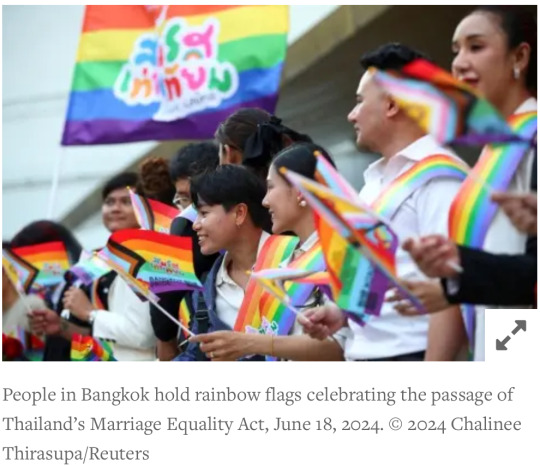
“Thailand’s Senate voted 130-4 today to pass a same-sex marriage bill that the lower house had approved by an overwhelming majority in March. This makes Thailand the first country in Southeast Asia, and the second in Asia, to recognize same-sex relationships. […] The Thai Marriage Equality Act […] will come into force 120 days after publication in the Royal Gazette. It will stand as an example of LGBT rights progress across the Asia-Pacific region and the world.”
2. One of world’s rarest cats no longer endangered

“[The Iberian lynx’s] population grew from 62 mature individuals in 2001 to 648 in 2022. While young and mature lynx combined now have an estimated population of more than 2,000, the IUCN reports. The increase is largely thanks to conservation efforts that have focused on increasing the abundance of its main food source - the also endangered wild rabbit, known as European rabbit. Programmes to free hundreds of captive lynxes and restoring scrublands and forests have also played an important role in ensuring the lynx is no longer endangered.”
3. Planning parenthood for incarcerated men
“[M]any incarcerated young men missed [sex-ed] classroom lessons due to truancy or incarceration. Their lack of knowledge about sexual health puts them at a lifelong disadvantage. De La Cruz [a health educator] will guide [incarcerated youths] in lessons about anatomy and pregnancy, birth control and sexually transmitted infections. He also explores healthy relationships and the pitfalls of toxic masculinity. […] Workshops cover healthy relationships, gender and sexuality, and sex trafficking.”
4. Peru puts endemic fog oasis under protection
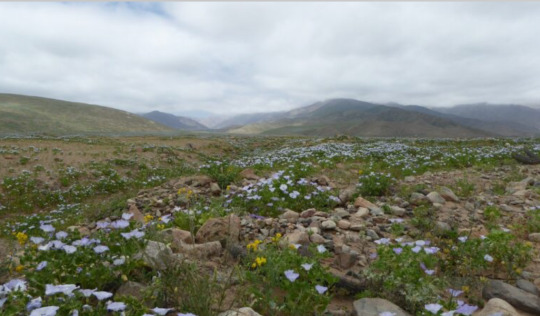
“Lomas are unique ecosystems relying on marine fog that host rare and endemic plants and animal species. […] The Peruvian government has formally granted conservation status to the 6,449-hectare (16,000-acre) desert oasis site[….] The site, the first of its kind to become protected after more than 15 years of scientific and advocacy efforts, will help scientists understand climatic and marine cycles in the area[, … and] will be protected for future research and exploration for at least three decades.”
5. Religious groups are protecting Pride events — upending the LGBTQ+ vs. faith narrative

“In some cases, de-escalation teams stand as a physical barrier between protesters and event attendees. In other instances, they try to talk with protesters. The goal is generally to keep everyone safe. Leigh was learning that sometimes this didn’t mean acting as security, but doing actual outreach. That might mean making time and space to listen to hate speech. It might mean offering food or water. […] After undergoing Zoom trainings this spring, the members of some 120 faith organizations will fan out across more than 50 Pride events in 16 states to de-escalate the actions of extremist anti-LGBTQ+ hate groups.”
6. 25 years of research shows how to restore damaged rainforest
“For the first time, results from 25 years of work to rehabilitate fire-damaged and heavily logged rainforest are now being presented. The study fills a knowledge gap about the long-term effects of restoration and may become an important guide for future efforts to restore damaged ecosystems.”
7. Audubon and Grassroots Carbon Announce First-of-its-Kind Partnership to Reward Landowners for Improving Habitats for Birds while Building Healthy Soils

“Participating landowners can profit from additional soil carbon storage created through their regenerative land management practices. These practices restore grasslands, improve bird habits, build soil health and drive nature-based soil organic carbon drawdown through the healthy soils of farms and ranches. […] Additionally, regenerative land management practices improve habitats for birds. […] This partnership exemplifies how sustainable practices can drive positive environmental change while providing tangible economic benefits for landowners.”
8. Circular food systems found to dramatically reduce greenhouse gas emissions, require much less agricultural land
“Redesigning the European food system will reduce agricultural land by 44% while dramatically reducing greenhouse gas emissions from agriculture by 70%. This reduction is possible with the current consumption of animal protein. “Moreover, animals are recyclers in the system. They can recycle nutrients from human-inedible parts of the organic waste and by-products in the food system and convert them to valuable animal products," Simon says.”
9. Could Treating Injured Raptors Help Lift a Population? Researchers found the work of rehabbers can have long-lasting benefits

“[“Wildlife professionals”] tend to have a dismissive attitude toward addressing individual animal welfare,” [… but f]or most raptor species, they found, birds released after rehabilitation were about as likely to survive as wild birds. Those released birds can have even broader impacts on the population. Back in the wild, the birds mate and breed, raising hatchlings that grow up to mate and breed, too. When the researchers modeled the effects, they found most species would see at least some population-level benefits from returning raptors to the wild.”
10. Indigenous people in the Amazon are helping to build bridges & save primates

“Working together, the Reconecta Project and the Waimiri-Atroari Indigenous people build bridges that connect the forest canopy over the BR-174 road[….] In the first 10 months of monitoring, eight different species were documented — not only monkeys such as the golden-handed tamarin and the common squirrel monkey (Saimiri sciureus), but also kinkajous (Potos flavus), mouse opossums (Marmosops sp.), and opossums (Didelphis sp.).”
Bonus: A rare maneless zebra was born in the UK
June 8-14 news here | (all credit for images and written material can be found at the source linked; I don’t claim credit for anything but curating.)
#hopepunk#good news#lgbtq#gay rights#gay marriage#same sex marriage#thailand#lynx#big cats#cats#endangered species#endangered#sex education#prison#peru#conservation#habitat#religion#pride#faith#pride month#lgbt pride#compassion#rainforest#birds#nature#climate change#wildlife rehab#wildlife#indigenous
1K notes
·
View notes
Text
Climate change-driven heatwaves threaten millions

Extreme record-breaking heat leads to severe crises across the world.
Already in 2024, from Israel, Palestine, Lebanon, and Syria in the West; to Myanmar, Thailand, Vietnam, China, and the Philippines in the East; large regions of Asia are experiencing temperatures well above 40°C (104°F) for days on end.
The heatwave has been particularly difficult for people living in refugee camps and informal housing, as well as for unhoused people and outdoor workers.
Using the Heat Index Calculator, at that temperature and a relative humidity of 50%, residents see a heat index of 55°C (131°F) - a temperature level humans cannot long survive:
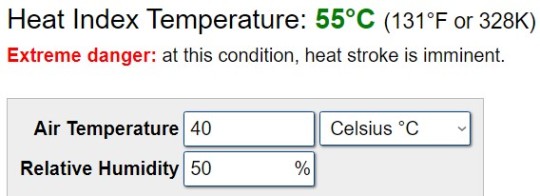
In February, the southern coastal zone of West Africa also experienced abnormal early-season heat. A combination of high temperatures and humid air resulted in average heat index values of about 50°C (122°F) - the danger level, associated with a high risk of heat cramps and heat exhaustion.
Locally, temperatures entered the extreme danger level associated with high risk of heat stroke, with values up to 60°C (140°F):

Even here at Ad Astra's HQ in Kansas, last summer we saw several days with high temperatures of 102°F (39°C) at 57% humidity, resulting in a heat index of 133°F (56°C):
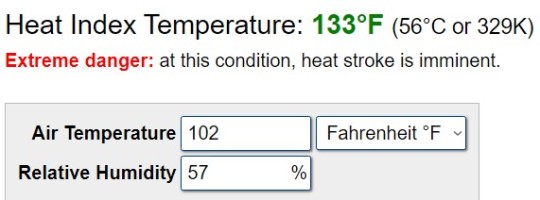
Of course, the major difference in survivability in Kansas versus some of the places suffering extreme heat right now is that air-conditioning abounds here. Those who live somewhere that faces extreme heat but can escape it indoors are a lot more likely to survive, but a person who lives somewhere without such life-saving gear faces not just discomfort, but heat stroke and even death.
This includes unhoused and poor people here in the wealthier parts of the world, who often do not have access to indoor refuge from the heat.
About 15% of US residents live below the poverty line. Many low-wage earners work outside in construction or landscaping, exposed to the ravages of heat. Many do not own an air conditioner, and those who do might need to budget their body's recovery from heat against cost to purchase and run cooling equipment. Because heat stress is cumulative, when they go to work the next day, they’re more likely to suffer from heat illness.
Bad as that is, for those living on the street, heatwaves are merciless killers. Around the country, heat contributes to some 1,500 deaths annually, and advocates estimate about half of those people are homeless. In general, unhoused people are 200 times more likely to die from heat-related causes than sheltered individuals.
For example, in 2022, a record 425 people died from heat in the greater Phoenix metro area. Of the 320 deaths for which the victim’s living situation is known, more than half (178) were homeless. In 2023, Texans experienced the hottest summer since 2011, with an average temperature of 85.3°F (30°C) degrees between June and the end of August. Some cities in Texas experienced more than 40 days of 100°F (38°C) or higher weather. This extreme heat led to 334 heat-related deaths, the highest number in Texas history and twice as many as in 2011.
The Pacific Northwest of Canada and the USA suffered an extreme heat event in June, 2021, during which 619 people died. Many locations broke all-time temperature records by more than 5°C, with a new record-high temperature of 49.6°C (121°F). This is a region ill-suited to such weather, and despite having relatively high wealth compared to much of the world, many homes and businesses there do not have air-conditioning due to a history of much lower temperatures.
Heatwaves are arguably the deadliest type of extreme weather event because of their wide impact. While heatwave death tolls are often underreported, hundreds of deaths from the February heatwave were reported in the affected countries, including Bangladesh, India, Thailand, Myanmar, Cambodia, and the Philippines.
Extreme heat also has a powerful impact on agriculture, causing crop damage and reduced yields. It also impacts education, with holidays having to be extended and schools closing, affecting millions of students - in Delhi, India, schools shut early this week for summer when temperatures soared to 47°C (117°F) at dangerous humidity levels:
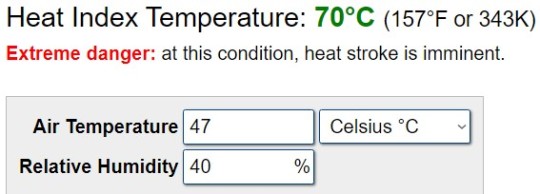
At 70°C (157°F !), humans simply cannot function and face imminent death, especially when humidity is high. This is the notion of "heat index," a derivative of "wet-bulb temperature."
Though now mostly calculated using heat and humidity readings, wet-bulb temperature was originally measured by putting a wet cloth over a thermometer and exposing it to the air.
This allowed it to measure how quickly the water evaporated off the cloth, representing sweat evaporating off skin.
The theorized human survival limit has long been 35°C (95°F) wet-bulb temperature, based on 35°C dry heat at 100% humidity - or 46°C (115°F) at 50% humidity. To test this limit, researchers at Pennsylvania State University measured the core temperatures of young, healthy people inside a heat chamber.
They found that participants reached their "critical environmental limit" - when their body could not stop the core temperature from continuing to rise – at 30.6°C wet bulb temperature, well below what was previously theorized. That web-bulb temperature parallels a 47°C (117°F) heat index.
The team estimates that it takes between 5-7 hours before such conditions reach "really, really dangerous core temperatures."
youtube
On March 5, 2024, Hong Kong saw temperatures of 27°C (80°F) with 100% humidity, which results in a heat index of 32.2°C (90°F) - seemingly not so bad until considering it's higher than the critical wet-bulb temperature. Also, if you watch the video, imagine the long-term effects of water accumulating in residences, such as dangerous mold.
We are witnessing the effects of climate change right now, all around the world, and rising temperatures are just the most-obvious (what we used to call "global warming"). Many, many other side-effects of climate change are beginning to plague us or headed our way soon, and will affect us all.
Unfortunately, those most affected - and those being hit the hardest right now - are people most vulnerable to heatwaves. With climate crises increasing in both intensity and frequency, and poverty at dangerous levels, we face a rapidly rising, worldwide crisis.
We must recognize the climate crisis as an international emergency and treat it as such. So much time, creative energy, resources, and life is wasted in war and the pursuit of profit or power - consider how much good could come from re-allocating those resources to ensuring a future for Earthlings, instead.
(Expect to see a "Science into Fiction" workshop on climate change coming soon - SF writers have a particular responsibility to address such important topics of change and global consequence.)
#climate crisis#climate change#global warming#heatwaves#poverty and homelessness#climate emergency#in response to asks for a post on this topic#stay tuned for posts on other crises arising from climate change
105 notes
·
View notes
Text
Excerpt from this EcoWatch story:
According to a new report from the nonprofit Pacific Institute, violent conflicts over water increased sharply in 2023. The report found there were nearly 350 water-related conflicts globally last year, a record high.
The latest update to Pacific Institute’s Water Conflict Chronology has revealed a huge increase in the number of water-related conflicts in 2023 compared to just 2022, with around a 150% rise. In 2022, there were 231 recorded conflicts over water, compared to the 347 recorded for 2023.
In comparing to recent decades, the contrast is even more stark. In 2000, there were just 22 water-related conflicts worldwide, Pacific Institute reported.
“The significant upswing in violence over water resources reflects continuing disputes over control and access to scarce water resources, the importance of water for modern society, growing pressures on water due to population growth and extreme climate change, and ongoing attacks on water systems where war and violence are widespread, especially in the Middle East and Ukraine,” Peter Gleick, senior fellow and co-founder of the Pacific Institute, said in a statement.
The organization records conflicts based on news reports, first-person accounts and databases. According to the data for 2023, water conflicts were most prominent in the Middle East, Southern Asia and sub-Saharan Africa. All three regions experienced increases in three different categories of conflict recorded: trigger, casualty and weapon.
Half of the conflicts were on water and water infrastructure, while 39% of new conflicts were over access or control of water, Pacific Institute reported.
Most conflicts, around 62%, were maintained within one country, while 38% of conflict events involved multiple countries, the report found.
35 notes
·
View notes
Text
Growth Strategies Adopted by Major Players in Turf Protection Market
In the dynamic landscape of the turf protection industry, key players like Syngenta Crop Protection AG (Switzerland), UPL Limited (India), Corteva Agriscience (US), Nufarm (US), Bayer AG (Germany), and BASF SE (Germany) are at the forefront of innovation and market expansion. These industry leaders are driving growth through strategic initiatives such as partnerships, acquisitions, and cutting-edge product developments, solidifying their positions as influential forces in shaping the future of the turf protection industry. Their efforts not only enhance their global presence but also set new benchmarks for industry standards and customer expectations. The global turf protection market size is estimated to reach $8.1 billion by 2028, growing at a 4.9% compound annual growth rate (CAGR). The market size was valued $6.4 billion in 2023.
Top Global Turf Protection Leaders to Watch in 2024
· Syngenta Crop Protection AG (Switzerland)
· UPL Limited (India)
· Corteva Agriscience (US)
· Nufarm (US)
· Bayer AG (Germany)
· BASF SE (Germany)
· SDS Biotech K.K. (Japan)
· AMVAC Chemical Corporation (US)
· Bioceres Crop Solutions (Argentina)
· Colin Campbell (Chemicals) Pty Ltd (Australia)
· ICL Group Ltd. (US)
Investments and Innovations: Key Strategies of Top Turf Protection Companies
🌱 Syngenta Crop Protection AG: Leading the Way in Integrated Pest Management
Syngenta Crop Protection AG, a global agribusiness based in Switzerland, operates prominently in the crop protection and seeds markets. The company offers a comprehensive range of herbicides, insecticides, fungicides, and seed treatments, helping growers worldwide enhance agricultural productivity and food quality. With a presence in over 90 countries, Syngenta’s reach is truly global. In October 2020, Syngenta further strengthened its position by acquiring Valagro, a leading biologicals company. Valagro’s strong presence in Europe, North America, Asia, and Latin America complements Syngenta’s existing crop protection chemicals. This acquisition allows Syngenta to offer more integrated pest management strategies that reduce reliance on synthetic chemicals, while Valagro’s expertise in plant nutrition promotes healthier turfgrass growth and improved soil health.
Know about the assumptions considered for the study
🌍 UPL Limited: Innovating Turf Management Solutions Globally
UPL Limited, formerly known as United Phosphorus Limited, is a global agrochemical company based in India, providing a wide range of agricultural solutions, including crop protection products, seeds, and post-harvest solutions. UPL is a key player in turf management, offering innovative solutions for golf courses, sports fields, and other turf areas. Their product portfolio includes herbicides, fungicides, insecticides, and plant growth regulators, all designed to enhance turf quality and health while effectively controlling pests and diseases. Operating in over 130 countries across North America, South America, Europe, and Asia Pacific, UPL has 28 manufacturing sites worldwide, solidifying its position as a leader in the global turf protection market.
🏆 Bayer AG: Streamlining for a Focused Future in Turf Protection
Bayer AG, a multinational pharmaceutical and life sciences company headquartered in Leverkusen, Germany, operates across three business segments: Pharmaceuticals, Consumer Health, and Crop Science. The company’s Crop Science division caters to the turf protection market, offering products such as herbicides, insecticides, and fungicides. With operations in over 90 countries, including regions like North America, South America, Europe, the Middle East, Africa, and Asia Pacific, Bayer maintains a strong global presence. In March 2022, Bayer sold its Environmental Science Professional business, which includes turf protection products, to private equity firm Cinven for USD 2.6 billion. This strategic divestment is part of Bayer’s ongoing efforts to streamline its portfolio and concentrate on core businesses, ensuring a more focused approach to its future operations.
16 notes
·
View notes
Text
Glimpses of Academic Procession - Graduation Ceremony, KCC ILHE Batch 2019
On October 28, 2023, the KCC Institute of Legal & Higher Education in Greater Noida held its Convocation for the graduating class of 2019-2022. The atmosphere was charged with excitement as the graduates eagerly awaited the moment when they would officially receive their degrees. The event commenced with a formal academic procession featuring distinguished guests, academic faculty, and the graduating students making their grand entrance.
The chief guest for the occasion was Padma shri Prof. (Dr.) Mahesh Verma, Vice Chancellor of GGSIPU. He delivered an inspiring convocation address, imparting valuable life lessons and insights to the graduating class of BBA, BCOM(H), BCA and BAJMC.
Graduates were bestowed with their degrees and accompanied by warm congratulations and well-wishes in presence of distinguished representatives from various sectors of the industry, as well as esteemed members of the academic council of KCCILHE.
Shri Pankaj Rai, Managing Director , Quality Austria Central Asia Private Limited
Dr. Lovneesh Chanana, Sr. Vice President & Regional Head for Government Affairs (Asia Pacific and Japan)
Advocate Shri Rajeev Tyagi, Member and Advisor, TAC, Ministry of Telecommunication, GOI.
Prof Vijita Singh Aggarwal, Director, International Affairs, GGSIPU
Professor (Dr.) Amrapal Singh Dean, USLLS.
Shri Sunil Mirza, GM (North India) Hindu Group of Publications.
Shri Atul Tripathi sir, Data Scientist
Shri Buba F Keinteh, Financial Attache Gambia Embassy.
Shri Pradip Bagchi, Senior Editor, Times of India.
Shri Vivek Narayan Sharma ,Advocate & Ex Joint Secretary, Supreme Court of India.
Biswajit Bhattacharya, Lead Client Partner, Automative Industry Leader India South Asia, IBM India Private limited.
Shri Dhruba Jyoti Pati , Director India Today Media Institute.
Shri Anil Singh, Manager, The Hindu City
Ceremony ended with pledging honor to our country by singing the national anthem. Subsequently, the celebration continued with a delightful lunch, memorable photo sessions, and the exchange of heartfelt messages among the attendees. The graduation ceremony concluded on a note of jubilation, leaving the graduates inspired to strive for greatness in their future endeavors.
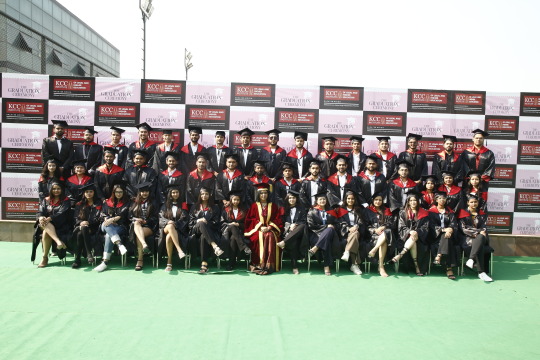


62 notes
·
View notes
Text
Valorant Esports
Valorant a 5v5 tactical shooter made by Riot Games same company that made League of Legends rose in popularity back at 2020. While the game gained popularity, Valorant announced its first ever official tournament "FIRST STRIKE".
youtube
FIRST STRIKE
was held online that started back in October 26 , 2020 and ended at December 6, 2020. There are 11 regions that are included in this tournament (North America, Europe, CIS, Turkey, Korea, Japan, Asia Pacific , etc...) each region will have there very own First Strike Champion.
North America "FIRST STRIKE" Champion.

Valorant Champions Tour
After the "FIRST STRIKE" ended fans wanted more of the competitive scene. As of early 2021 Valorant announced the "Valorant Champions Tour" will be held international and in ICELAND "Masters Reykjavík" will start off the champions tour. This will be the first Valorant tournament that will not be held online but in LAN (Local Area Network). 8 teams from around the world will be fighting to the top to be the best team in the world. "Masters Reykjavík" begun May 24, 2021 and ended May 31, 2021.
To qualify to this tournament Valorant held a "Valorant Challengers" that will be held regional like the "FIRST STRIKE" tournament but the top teams in each region will have a chance to play at "Masters Reykjavík".
First ever "Masters Champion" Sentinels.

Masters Tournament will lead to the VCT finale "Valorant Champions"
First "Valorant Champions" winner, Acend.

Valorant Champions Tournament 2022 changed the format of their schedule and will have the "Valorant Champions" held earlier rather than to be held at the end of the year. This will follow through until 2024

PREMIER
Premier will be a game mode inside Valorant that will have you play with your team with same ranks and each week there will be a match against teams that have the same rank and skill level as you. This game mode will let casual players try to play at the highest level and will have a chance to get their team to a official Valorant Tournament. Open Beta launched at April 25, 2023 and the official was released at August 29, 2023.
youtube
Valorant Champions Tour 2025
Valorant once again changed the format for Challengers, Game Changers, VCT and changed their schedule. The new schedule looks like they want to have more events and try to fit all tournaments for the whole year and to shorten the off season. Valorant also released the location for next year tournament.
Masters Bangkok
Masters Toronto
Champions Paris

10 notes
·
View notes
Note
Hey I thought you might appreciate a heads up that the yellow-legged hornet (Vespa velutina) has been spotted in Savannah, Georgia. 😞
Nice. Well, not nice news. But glad that you thought of me. Thank you.
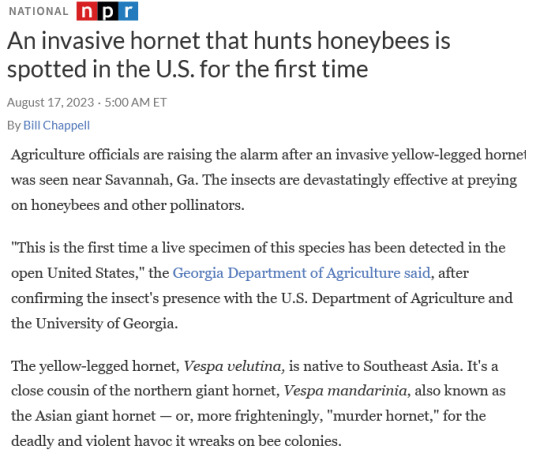
(For other people who have yet to fully embrace and explore their innate love of hornets, this Vespa velutina hornet is originally from Southeast Asia. This creature is closely related to Vespa mandarinia, the creature derisively referred to in the US as "murder hornet" or "Asian giant hornet", originally from South/East Asia, which is now apparently established near in the Salish Sea region near Bellingham, Vancouver, and Nanaimo.)
Here's a look at where the giant hornets now live in North America, along with the distribution of some other large hornets which might be mistaken as Vespa manadrinia/velutina:
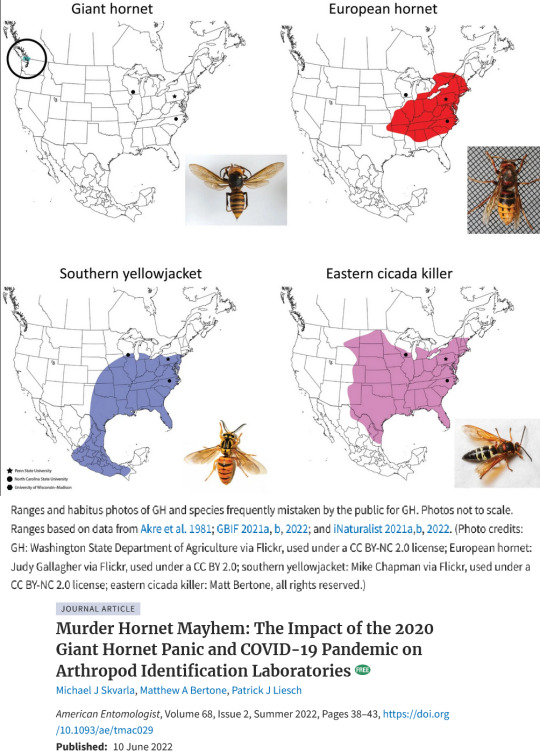
The map was originally published in 2022 in American Entomologist, displaying distribution range of (non-native) giant hornet; (non-native) European hornet; (native) southern yellowjacket; and (native) eastern cicada killer. The article also identifies a few few other species which might be mistaken for "murder hornets": great golden digger wasp, bald-faced hornet, German yellowjacket, red-legged cannibal fly, and pigeon horntail. (Available to read for free online; article title in the source/caption beneath the map.)
I've had many memorable encounters with large (native) bald-faced hornets in dense cedar-hemlock rainforest-y places. And coincidentally, the Pacific Northwest is also now apparently the North American home/homebase of Vespa mandarinia. So here are some other PNW wasps/hornets in comparison, from Oregon State University Extension Catalog (2022):
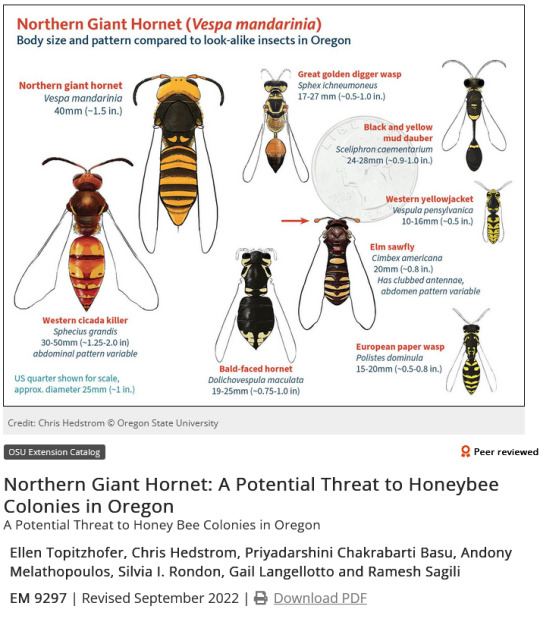
From 2020 research on potential dispersal of Vespa mandarinia over a couple of decades (not necessarily a good or realistic representation, not inevitable, kinda just "potential"):

Apparently Vespa mandarinia haven't yet been encountered outside of the general Vancouver area during targeted samples:

I know that you too are fond of wasps/hornets, and are aware of their popular demonization, the way that they're feared, etc. In July 2022, the Entomological Society of America put out an online resource thing that explains why they don't like the name "Asian giant hornet" for Vespa mandarinia and Vespa velutina, instead adopting "northern giant hornet" and "yellow-legged hornet" (which you called the creature, too!) because of the racialized/xenophobic implications. ("Northern Giant Hornet Common Name Toolkit" available at: entsoc.org/publications/common-names/northern-giant-hornet) They say: '"Murder hornet" unnecessarily invokes fear and violence, which impede accurate public understanding of the insect and its biology and behavior. While "Asian" on its own is a neutral descriptor, its association with a pest insect that inspires fear and is targeted for eradication may bolster anti-Asian sentiment in some people - at a time when hate crimes and discrimination against people of Asian descent in the United States are on the rise.'
Which, for me, brings to mind this recent book from Jeannie Shinozuka:

From the publisher's blurb: 'In the late nineteenth century, increasing traffic of transpacific plants, insects, and peoples raised fears of a “biological yellow peril” [...]. Over the next fifty years, these crossings transformed conceptions of race and migration, played a central role in the establishment of the US empire and its government agencies, and shaped the fields of horticulture, invasion biology, entomology, and plant pathology. [...] Shinozuka uncovers the emergence of biological nativism that fueled American imperialism and spurred anti-Asian racism that remains with us today. [...] She shows how the [...] panic about foreign species created a linguistic and conceptual arsenal for anti-immigration movements that flourished in the early twentieth century [...] that defined groups as bio-invasions to be regulated—or annihilated.'
A lot going on at that time with insects, empire, and xenophobia. In the 1890s, the British Empire was desperately searching for a way to halt malaria, and mosquitoes had just been discovered as vectors of malaria. And from Nobel prize podium lectures to popular media newspapers and academic journals, there was all kinds of talk about how "bacteria/viruses/insects are the greatest enemy of the Empire" and whatever. The US was also expanding in the Caribbean, Central America, Pacific islands towards East Asia, etc. Tropical plantations were proliferating, not just in Dutch Java or British India, but also in US administered Central America. And so insects were perceived not just as a threat to the human body of the British soldier or American administrator; insects were also a threat to profits, as insect pests threatened monoculture plantations and agriculture.
That same time period saw the US invasion of the Philippines and exports of products from the islands; the US annexation of Hawai'i, and elevating rivalry with Japan; the 1882 passage of the notorious Chinese Exclusion Act; US control of Cuba and Puerto Rico; expansion of US fruit corporations in Central America and US sugarcane plantations in Cuba/Hawai'i, where insect pests threatened plantation profits; the advent of "Yellow Peril" tropes and fear of invasion in science fiction literature; the detaining of half a million (mostly Chinese) people at the medical quarantine processing center that the US Public Health Service operated at Angel Island in San Francisco; and US insect extermination projects, mosquito control campaigns, and medical policing of local people in Cuba and the Panama Canal Zone (where US authorities detained local people for medical testing).
A lot to consider.
58 notes
·
View notes
Text
Is China a part of the global south?
Beijing certainly thinks so. For instance, at the recently concluded Forum on China-Africa Cooperation, a conference held every three years between China and African leaders, Chinese President Xi Jinping spoke of the global south’s “shared path toward modernization.” China has set up a development fund containing the term “South-South.” And Foreign Minister Wang Yi has also explicitly stated more than once that China is and will always be a member of the global south.
Though the terms used have changed over time, China’s rhetorical embrace of the developing world is not exactly new. Its roots go back to the early years of Chinese Communist Party rule. After the revolutionary fervor of the early 1950s subsided somewhat, China participated in the historic 1955 Bandung Conference that brought Asian and African leaders from recently decolonized countries together in a common front against global inequities. In 1964, Premier Zhou Enlai, Mao Zedong’s righthand man, formulated China’s Eight Principles for Economic Aid and Technical Assistance to Other Countries. Mao’s own worldview defined two “intermediate zones” between the United States and the Soviet Union, the latter zone comprising Asia, Africa, and Latin America.
The intermediate zones framing later morphed into the Three Worlds theory in 1974. In a conversation with Zambian President Kenneth Kaunda, Mao defined the “Third World” as including Africa, Latin America, and all of Asia, except Japan. This brief reference was elaborated on at length in a famous speech by Deng Xiaoping to the U.N. General Assembly in the same year, in which he said: “China belongs to the Third World.”
Mao, like many of his contemporaries, defined the Third World in predominantly economic and postcolonial terms. The framing made sense in the 1970s, when China was among the world’s poorer countries. The average Chinese lived no better, and in some cases worse, than the wide swath of recently decolonized countries.
Fast-forward to today, and much has changed. A different understanding of the meta-region stretching from Latin America to Southeast Asia and the Pacific Islands is needed—and in turn, China’s place within it must be reconsidered.
In this meta-region, 45 states that the United Nations has dubbed “least developed countries” remain mired in poverty and, in some cases, state failure. But about 80 others have grown substantially. Many, especially in Asia, made globalization and capitalism their own and turbocharged growth with corresponding social investments. They industrialized, integrated with the global economy, and built respectable levels of domestic infrastructure.
China itself is among the biggest beneficiaries of this transformation—from a country that experienced state-induced famines during the disastrous 1958-62 Great Leap Forward to now a highly industrialized, upper-middle-income country.
As economies diverge and the colonial era recedes into the past, the term “global south” has gained currency, especially since Russia’s invasion of Ukraine in 2022. It is best described as a “geopolitical fact,” a vast middle that sits outside the great-power system made up of the three great powers and core U.S. allies in Europe, East Asia, and Australasia. The “rest” have achieved varied levels of economic and social development but remain outside the select club of core alliances and global rulemaking. By definition, therefore, a great power cannot be a part of the global south.
China’s sheer size; high levels of GDP, trade, investment, and increasingly innovation; and successful military modernization mean that it now qualifies as a great power. It has joined Russia and the United States in this select category—though the United States is clearly the most powerful of the three and Russia barely makes the grade.
China is indeed working closely with a few global south states on major issues, for example with Brazil on a Ukraine peace plan, and as a part of the BRICS grouping. But Beijing’s global south rhetoric, while drawing on a real shared history, is today a stratagem, designed to win influence among the developing world and further its aims of influencing the global order. If anything, China’s emergence as a great power opens the door for a divergence from the global south on three important fronts: trade and investment, climate, and geopolitics.
Divides on trade are already visible. Middle-income global south countries such as Indonesia and Chile have recently slapped tariffs on Chinese imports as China has increasingly shifted into advanced manufacturing. Jakarta has just banned a giant Chinese online retailer, citing threats to local businesses. Mexico wants to reduce Chinese imports in its supply chain. Concerns over local trade have also triggered actions against Chinese imports in Brazil.
Meanwhile, Beijing’s flagship investment program, the Belt and Road Initiative, has become much smaller and more targeted of late, with spending falling off sharply as a slowing China focuses more at home. China is also on the “other side” when it comes to negotiating debt relief with poorer states in the G-20’s Common Framework, an odd position for a nation that claims to still be developing.
China and the global south have historically cooperated closely on climate change in the G-77+China coalition. They routinely push the U.N. principle of “common but differentiated responsibilities” (CBDR) and legitimately demand much greater climate finance commitments from wealthy states. The CBDR principle puts the onus on financing the energy transition on the global north, since wealthy countries have been the dominant contributors to destructive climate change due to their much larger cumulative carbon emissions. Unsurprisingly, Washington tends to minimize or ignore CBDR in climate negotiations.
But China’s own emissions have risen to the point that it has itself become a major contributor to not only annual but also historical emissions. With 14.7 percent of the global share, China now ranks third in cumulative emissions since 1750, not far behind the United States and the European Union. (The leading global south emitter, India, comes in much lower at nearly 3.4 percent.) The CBDR principle puts China on the side of wealthy states much more than developing countries.
China could justifiably point to its already significant efforts as a source of climate finance. But it will resist what should be a logical shift in its status and oppose formally taking on climate finance targets.
China and the global south may also yet diverge on the broader geopolitical plane. Highly militarized U.S.-China competition can destabilize the global order and risk major conflict; it is therefore not in the global south’s interests. Any actions by Beijing contributing to regional or global destabilization will not be welcomed in the global south. (The same is true for any such behavior by Washington.)
But China’s relative weakness compared with the United States, and an economic slowdown at home, also creates incentives for a revived G-2 in order to craft updated rules of global governance. Xi seemed to propose exactly this last year.
Washington is currently in no mood to engage in such a conversation with Beijing due to China’s perceived threat to its global primacy, sharp differences over Taiwan, and the Russia-Ukraine war. But as planetary challenges multiply, and as China closes the gap in strategic innovation despite its economic crunch, both sides may be incentivized toward deeper, though sectoral, cooperation—perhaps after a nasty crisis that stops short of war.
Any new, future G-2, even if partial, would sit uneasily with most of the global south, as the latter’s demands might not be factored in a backroom deal between the two most powerful states in the international system. The very act of excluding these states from such a conversation would also rankle. The net effect would be to widen their divide with Beijing.
China could bridge its growing gap with the global south by being more proactive on issues such as debt, climate, and trade and refraining from provocative actions in theaters such as the South China Sea. Continuing U.S. failures that cost the lives of innocents (such as in the Middle East escalation) or U.S. over-militarization in Asia could also ensure China remains attractive in Asia, Africa, and Latin America.
While Beijing has traditionally enjoyed a natural convergence with the global south, the future looks a lot more complicated.
5 notes
·
View notes
Text
CHANCAY, Peru (AP) — On the edge of Peru’s coastal desert, a remote fishing town where a third of all residents have no running water is being transformed into a huge deep-water port to cash in on the inexorable rise of Chinese interest in resource-rich South America.
The megaport of Chancay, a $1.3 billion project majority-owned by the Chinese shipping giant Cosco, is turning this outpost of bobbing fishing boats into an important node of the global economy.
From the presidential palace in Lima, 60 kilometers (37 miles) south of the port inauguration ceremony, China’s President Xi Jinping watched a livestream of the ribbon-cutting alongside his Peruvian counterpart, Dina Boluarte, late Thursday.
The leaders' faces appeared on a giant screen in Chancay, where engineers in bright orange safety vests declared the port operational to the swell of string instruments. Chinese dancers with red dragon-costume heads seemingly burst out of nowhere to prance around the docking station as a crane lowered the first aluminum containers onto a berthed cargo ship.
“Considerable income and enormous job opportunities will be generated for Peru,” Xi said from Lima, where world leaders were preparing to gather for the Asia-Pacific Economic Cooperation forum. “This will generate tangible results for the people of the region.”
But the development — expected to encompass 15 quays and a large industrial park drawing more than $3.5 billion in investment over a decade — has met a skeptical response from impoverished villagers, who say it is depriving them of fishing waters and bringing no economic benefit to locals.
“Our fishing spots no longer exist here. They destroyed them,” said 78-year-old fisherman Julius Caesar — “like the emperor of Rome” — gesturing toward the dockside cranes. “I don't blame the Chinese for trying to mine this place for all it's worth. I blame our government for not protecting us.”
The Peruvian government hopes the port will become a strategic transshipment hub for the region, opening a new line connecting South America to Asia and speeding trade across the Pacific for Peru's blueberries, Brazil's soybeans and Chile's copper, among other exports.
Officials cite the port's potential to generate millions of dollars in revenues and turn coastal cities into so-called special economic zones with tax breaks to lure investment.
“We Peruvians are focused primarily on the well-being of Peruvians,” Foreign Minister Elmer Schialer told The Associated Press.
But many of Chancay's 60,000 residents are unconvinced. Fishermen returning to port with smaller catches complain that they have already lost out.
The dredging of the port — which sucked sediment from the seabed to create a shipping channel 17 meters (56 feet) deep — has ruined fish breeding grounds, locals said.
“I’ve been out in the water all day and I’m always needing to venture farther,” said Rafael Ávila, a 28-year-old fisherman with sand in his hair, returning to shore empty-handed and exhausted.
“This used to be enough,” he said, pointing at his painted dinghy. “Now I need a larger, more expensive boat to reach the fish."
To make extra cash, Ávila started offering occasional joyrides to selfie-taking visitors wanting to get a glimpse at the hulking Chinese ships.
With some of the world's largest container ships to berth at Chancay Port in January 2025, residents also fear the arrival of pollution and oil spills. In 2022, a botched tanker delivery at La Pampilla refinery nearby sent thousands of barrels of crude oil spilling into Peru's famously biodiverse waters, killing countless fish and putting legions of fishermen out of work.
Today a glance at the moribund town center, featuring mostly empty seafood restaurants, tells the story of diminished fishing stocks and decimated tourism even without the port being operational.
The port's breakwater changed the currents and destroyed good surfing conditions, locals said, affecting everyone from ice vendors to truckers to restaurant owners. “No to the megaport” is spray-painted on a wall overlooking the waterfront.
“This port is a monster that's come here to screw us,” said 40-year-old Rosa Collantes, cleaning and gutting slimy drum fish on the shore. “People come to the port and they say ‘Wow, tremendous!' but they don't see the reality.”
Port authorities say they're aware of the stark contrast between the sleek modern port and the surrounding village of Chancay, where many live on unpaved roads lined with ragged shacks and littered with trash.
“You cannot build a state-of-the-art port and have a city next to it that has no drinking water, no sewage, a collapsing hospital and no educational centers,” said Mario de las Casas, a manager for Cosco in Chancay, adding that the company had already launched studies to determine how the port could help reduce inequality and spur local growth.
“The port should not be a blemish,” De las Casas said.
4 notes
·
View notes
Text
[Tour Date] Asia-Pacific 2022

The Regime World Tour 2022: Asia-Pacific
Tickets on sale Friday August 12, 2022 11am local time
November 2022
November 25 Tokyo November 27 Taipei November 30 Manila
December 2022
December 2 Bangkok December 4 Singapore December 6 Jakarta December 10 Kuala Lampur December 13 Auckland, NZ December 15 Melbourne December 17 Sydney
regimetour.com
#2022#the regime world tour 2022#dpr ian#christian yu#dpr#dream perfect regime#yu barom#asia pacific 2022#tour dates 2022#tour dates#2022 tour dates#regime tour 2022#regime tour asia pacific#dpr live
0 notes
Text
By: Bernard Lane
Published: Apr 14, 2024
Nine of the 15 gender clinics in a landmark international survey for the Cass review have admitted they do not routinely collect outcome data on their young patients.
This survey, together with a new evaluation of treatment guidelines for gender dysphoria, gives unprecedented insights into the workings of gender clinics around the world offering puberty blockers and cross-sex hormones to minors.
In the 2022-23 survey, six clinics said they “routinely collected some outcome data”: one of these clinics gave no further detail; one noted the number of patients discontinuing treatment; another used measures of quality of life; two were taking part in cohort studies; and the sixth clinic repeated some baseline assessments. Nine clinics acknowledged “not routinely collecting outcome data.”
The report of the survey results1, published by researchers from the University of York earlier this month, identified clinics by country, not name. Of the clinics that took part, Australia and the Netherlands were prominent with five and four clinics respectively.
Poor data collection was central to the controversy over the London-based Tavistock youth gender clinic.
The Cass review had planned to run a data-linkage study—with help from adult gender clinics—to learn the outcomes of the Tavistock’s 9,000-odd former patients.
The missing long-term data would allow clinicians, young patients and parents to make informed decisions about treatment. The review said it was to be the largest study of its kind in the world.
However, six of the seven adult clinics refused to co-operate. One stated reason was that “the study outcomes focus on adverse health events, for which the clinics do not feel primarily responsible.”
Another adult clinic said, “The unintended outcome of the study is likely to be a high-profile national report that will be misinterpreted, misrepresented or actively used to harm patients and disrupt the work of practitioners across the gender dysphoria pathway.”
On April 12, however, The Times newspaper reported that the uncooperative adult clinics had “bowed to pressure to share [the] missing data”.
Mostly medical
In the York University international survey, ordered by the Cass review, all 15 youth gender clinics said they used a multi-disciplinary team, but researchers concluded there was a “paucity” of psychosocial therapy interventions such as psychotherapy or cognitive behaviour therapy. Five clinics did not offer any of these non-medical interventions in-house.
All gender clinics told researchers that “genital reconstructive surgery”—the creation of a pseudo vagina, for example—was “accessible only from age 18.” The youngest age for “masculinising chest surgery” (a double mastectomy) was reported as 16. In fact, there are documented cases in Australia of 15-year-olds approved for transgender mastectomy. Genital surgery is legally available to minors2 in Australia and practised in America.
“Only five clinics reported routine discussion of fertility3 preferences, and only two discussed sexuality4. Finland was the only country to report routinely assessing for history of trauma5,” the final Cass report says in its commentary on the survey.
In separate studies for the Cass review, three independent reviewers evaluated the quality of 21 guidelines for treatment of gender dysphoria in minors.
Included were international guidelines (from the Endocrine Society and the World Professional Association for Transgender Health or WPATH); documents from North America (for example, the 2018 policy statement from the American Academy of Pediatrics); from Europe (the guideline of the UK Royal College of Psychiatrists, for example, and Denmark’s); as well as guidelines from the Asia-Pacific and Africa.
“WPATH has been highly influential in directing international practice, although its guidelines were found by the University of York appraisal process to lack developmental rigour,” the Cass report says.
The York researchers chart patterns of “circular” cross-referencing between guidelines to create a misleading impression of consensus in favour of the medicalised “gender-affirming” treatment approach.
“The guideline appraisal raises serious questions about the reliability of current guidelines. Most guidelines have not followed the international standards for [rigorous and independent] guideline development. Few guidelines are informed by a systematic review of empirical evidence [the gold standard for assessing the evidence supporting a health intervention] and there is a lack of transparency about how recommendations were developed,” the Cass report says.
“Healthcare services and professionals should take into account the variable quality of published guidelines to support the management of children and young people experiencing gender dysphoria. The lack of independence in many national and regional guidelines, and the limited evidence-based underpinning current guidelines, should be considered when utilising these for practice.”
The Cass report says it is “imperative” that gender clinic staff be “cognisant of the limitations in relation to the evidence base and fully understand the knowns and the unknowns.”
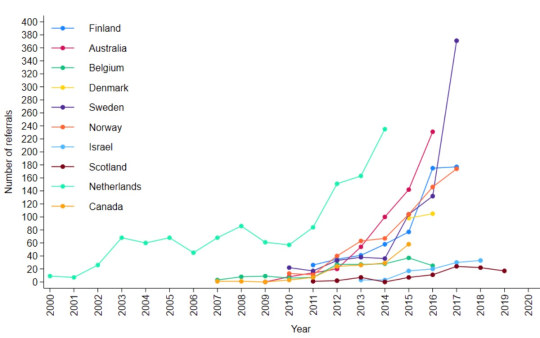
[ Chart: Number of youth gender clinic referrals over time by country. Source: Cass report ]
Bum steer
Staff at the Tavistock clinic misled patients and parents, or failed to correct their misconceptions, according to a new report from the Multi-Professional Review Group (MPRG) given oversight of treatment decisions from 2021.
These shortcomings of clinicians included playing down the extent of the unknowns of hormonal treatment; not explaining that puberty blockers are being used unlicensed and off-label; not challenging the reassuring but false parallel with the licensed use of puberty blockers for precocious (premature) puberty; not discussing the possibility that blockers will pause or slow psychosexual development; and not sharing figures showing the vast majority of children started on puberty blockers will go on to cross-sex hormones supposed to be taken lifelong.
The MPRG was also troubled by clinical documents showing misunderstanding of “the outcome of physical treatments” on the part of patients and parents.
In the York University study of treatment guidelines for gender dysphoria, only two were recommended for use by all three reviewers. These were recent, more cautious policies from Finland and Sweden. Both followed independent systematic reviews showing the evidence base for hormonal and surgical treatment of minors to be very weak and uncertain. Like the Cass review itself, the 2020 Finnish and 2022 Swedish guidelines recognise that puberty blockers are experimental and should not be routine treatment.
Although all the guidelines in the study agreed on the need for a multidisciplinary team to treat gender-distressed minors, the “most striking problem” shown by analysis of these documents was “the lack of any consensus6 on the purpose of the assessment process”, the Cass report says.
“Some guidelines were focused on diagnosis, some on… eligibility for hormones, some on psychosocial assessment, and some on readiness for medical interventions7.
“Only the Swedish and [the 2022] WPATH 8th version guidelines contain detail on the assessment process8. Both recommend that the duration, structure and content of the assessment be varied according to age, complexity and gender development.
“Very few guidelines recommend formal measures/clinical tools to assess gender dysphoria, and a separate analysis demonstrated that the formal measures that exist are poorly validated.”
Nor was there any consensus on “when psychological or hormonal interventions should be offered and on what basis.”
A survey of staff at the Tavistock clinic, undertaken as part of the Cass review, found specialists divided on whether or not “assessment should seek to make a differential diagnosis, ruling out other potential [non-gender9] causes of the child or young person’s distress.”
Arguing for an ambitious research program well beyond a possible clinical trial of puberty blockers, the Cass report says the field of youth gender dysphoria is one of “remarkably weak evidence” where health professionals are “afraid to openly discuss their views” because of vilification and bullying.
“Although some think the clinical approach should be based on a social justice model, the NHS works in an evidence-based way,” the report says.
“The gaps in the evidence base regarding all aspects of gender care for children and young people have been highlighted, from epidemiology through to assessment, diagnosis10 and intervention. It is troubling that so little is known about this cohort and their outcomes.
“Based on a single Dutch study, which suggested that puberty blockers may improve psychological wellbeing for a narrowly defined group of children with gender incongruence [or dysphoria], the practice spread at pace to other countries.
“Some practitioners abandoned normal clinical approaches to holistic assessment, which has meant that this group of [gender-distressed] young people have been exceptionalised compared to other young people with similarly complex presentations.”
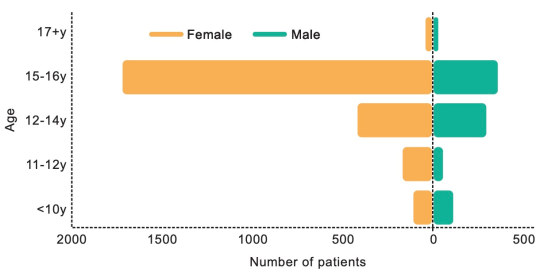
[ Chart: Age and sex on referral to the Tavistock clinic from 2018-2022. Source: Cass report ]
Who to trust?
The Cass report says the missing evidence “makes it difficult to provide adequate information on which a young person and their family can make an informed choice.”
“A trusted source of information is needed on all aspects of medical care, but in particular it is important to defuse/manage expectations that have been built up by claims about the efficacy of puberty blockers.
“The option to provide masculinising or feminising hormones from the age of 16 is available, but the [Cass] review would recommend an extremely cautious clinical approach and a strong clinical rationale for providing hormones before the age of 18. This would keep options open during this important developmental window, allowing time for management of any co-occurring [non-gender] conditions11, building of resilience, and fertility preservation, if required.”
The review stresses that “consent is more than just capacity and competence. It requires clinicians to ensure that the proposed intervention is clinically indicated as they have a duty to offer appropriate treatment. It also requires the patient to be provided with appropriate and sufficient information about the risks, benefits and expected outcomes of the treatment.”
“Assessing whether a hormone pathway is indicated is challenging. A formal diagnosis of gender dysphoria is frequently cited as a prerequisite for accessing hormone treatment. However, it is not reliably predictive of whether that young person will have long-standing gender incongruence in the future, or whether medical intervention will be the best option for them.”
Advocates for the gender-affirming approach assert that detransition and treatment regret are vanishingly rare, whereas suicide risk for those denied medical intervention is claimed to be very high.
The Cass report says: “It has been suggested that hormone treatment reduces the elevated risk of death by suicide in this population, but the evidence found did not support this conclusion.”
“The percentage of people treated with hormones who subsequently detransition remains unknown due to the lack of long-term follow-up studies, although there is suggestion that numbers are increasing.”
The report cites three reasons why the true extent of detransition is unlikely to be clear for some time—patients who decide medicalisation was a mistake may not wish to return to their former clinic to announce this fact; there is a post-treatment honeymoon period and clinicians suggest it may take 5-10 years before a decision to detransition; and the surge in patient numbers only began within the last decade.
Faced with uncertainty and a lack of good evidence, those with responsibility—from health ministers and hospital managers down to gender clinicians—rely on treatment guidelines supposed to advise on clinical practice according to the “best-available” evidence and expert opinion.
In the York University guideline analysis, the 21 documents were rated on six domains, the key two being the rigour of their development and their editorial independence.
“[Rigour] includes systematically searching the evidence, being clear about the link between recommendations and supporting evidence, and ensuring that health benefits, side effects and risks have been considered in formulating the recommendations,” the Cass report says.
Only the Finnish and Swedish guidelines scored above 50 per cent for rigour. Only these two documents, the Cass report says, link “the lack of robust evidence about medical treatments to a recommendation that treatments should be provided under a research framework or within a research clinic. They are also the only guidelines that have been informed by an ethical review conducted as part of the guideline development.”
“Most of the guidelines described insufficient evidence about the risks and benefits of medical treatment in adolescents, particularly in relation to long-term outcomes. Despite this, many then went on to cite this same evidence to recommend medical treatments,” the report says.
“Alternatively, they referred to other guidelines that recommend medical treatments as their basis for making the same recommendations. Early versions of two international guidelines, the Endocrine Society 2009 and WPATH 7th version guidelines, influenced nearly all the other guidelines.
“These two guidelines are also closely interlinked, with WPATH adopting Endocrine Society recommendations, and acting as a co-sponsor and providing input to drafts of the Endocrine Society guideline. The WPATH 8th version cited many of the other national and regional guidelines to support some of its recommendations, despite these guidelines having been considerably influenced by the WPATH 7th version.
“The circularity of this approach may explain why there has been an apparent consensus on key areas of practice despite the evidence being poor.”
Sometimes these gender-affirming guidelines seek to buttress a strong evidence claim with a citation to a study that is weak or involves a different patient group.
The Cass report notes that, “The WPATH 8th version’s narrative on gender-affirming medical treatment for adolescents does not reference its own systematic review [of the evidence], but instead states: ‘Despite the slowly growing body of evidence supporting the effectiveness of early medical intervention, the number of studies is still low, and there are few outcome studies that follow youth into adulthood. Therefore, a systematic review regarding outcomes of treatment in adolescents is not possible’.”
Despite WPATH insisting such an evidence review is not possible, this is precisely what health authorities and experts have undertaken since 2019 in several jurisdictions—Finland, Sweden, the UK National Institute for Health and Care Excellence, Florida, Germany, and University of York research commissioned by the Cass review.
Yet in the 8th and current version of its guideline, WPATH makes the confident statement that, “There is strong evidence demonstrating the benefits in quality of life and well-being of gender-affirming treatments, including endocrine and surgical procedures… Gender-affirming interventions are based on decades of clinical experience and research; therefore, they are not considered experimental, cosmetic, or for the mere convenience of a patient. They are safe and effective at reducing gender incongruence and gender dysphoria”.
But WPATH “overstates the strength of the evidence” for its treatment recommendations, the Cass report says.
--
1 In the survey, there was one clinic each from Belgium, Denmark, Finland, Northern Ireland, Norway and Spain. The response rate was 38 per cent.
2 In Australia there is no good public data on trans surgery for minors.
3 Early puberty blockers followed by cross-sex hormones are expected to sterilise young people and may also impair future sexual function.
4 Some sizeable proportion of gender clinic patients might grow up in healthy bodies and accept their same-sex attraction were it not for trans medicalisation, according to testimony from detransitioners, clinicians’ reports and data.
5 Trauma from a history of sexual abuse, for example, or exposure to domestic violence is thought to be among the many possible underlying causes of what presents as gender dysphoria. The Multi-Professional Review Group (MPRG), given oversight of Tavistock treatment decisions from 2021-23, was troubled by the lack of curiosity by the clinic’s staff about the effect of a child’s “physical or mental illness within the family, abusive or addictive environments, bereavement, cultural or religious background, etc.”
6 Critics of the “gender-affirming” treatment approach say it is not mainstream medicine because the “trans child” in effect self-diagnoses while clinicians avoid differential diagnosis and attribute mental health disorders and other pre-existing issues to a “transphobic” society.
7 “In most cases [at the Tavistock clinic] children and parents were asking to progress on to puberty blockers from the very first appointment”, according to the MPRG.
8 In the MPRG’s opinion, the patient notes from the Tavistock “rarely provide a structured history or physical assessment, however the submissions to the MPRG suggest that the children have a wide range of childhood, familial and congenital conditions.”
9 Once referred to the Tavistock, patients typically were no longer seen by child and adolescent mental health services.
10 According to the MPRG, gender dysphoria in the diagnostic manual DSM-5 ���has a low threshold based on overlapping criteria, and is likely to create false positives. Young people who do not go on to have an enduring cross-sex gender identity may have met the criteria in childhood. And early to mid-childhood social transition may be influential in maintaining adherence to the criteria. Sex role and gender expression stereotyping is present within the diagnostic criteria—preferred toys, clothes, etc—not reflecting that many toys, games and activities [today] are less exclusively gendered than in previous decades.”
11 The MPRG said it was “notable that until the child and family’s first appointment at [the Tavistock] they have received little, if any, support from health, social care, or education professionals. Most children and parents have felt isolated and desperate for support and have therefore turned for information to the media and online resources, with many accessing LGBTQ+ and [gender dysphoria] support groups or private providers which appear to be mainly ‘affirmative’ in nature, and children and families have moved forward with social transition. This history/journey is rarely examined closely by [Tavistock clinicians] for signs of difficulty [or] regret.”
==
Critics have described "gender affirming care" - that is, sex-trait modification - as "medical experimentation." This is incorrect. In a medical experiment, you actually collect data and monitor the participants in the experiment. They don't do that. They're cowboys violating all medical ethics - "first, do no harm" - for ideology, money or both.
#Bernard Lane#Cass review#Cass report#Dr. Hilary Cass#Hilary Cass#gender affirming care#gender affirming healthcare#gender affirmation#medical scandal#medical malpractice#sex trait modification#medical corruption#World Professional Association for Transgender Health#WPATH#ethics violations#medical ethics#unethical#gender ideology#gender identity ideology#queer theory#intersectional feminism#religion is a mental illness
13 notes
·
View notes
Text
henjin comment:
Did you know that General Dynamics IT was contracted by the Pentagon to run an anti-vaccine psyop campaign on Twitter and other social media? It seems like a conflict of interest considering that the management of VAERS was outsourced to General Dynamics IT in 2020. By 2022 GDIT had received over 35 million USD to manage VAERS according to Josh Guetzkow's calculation ( ). Reuters wrote this about the psyop campaign (https://www.reuters.com/investigates/special-report/usa-covid-propaganda/): > To implement the anti-vax campaign, the Defense Department overrode strong objections from top U.S. diplomats in Southeast Asia at the time, Reuters found. Sources involved in its planning and execution say the Pentagon, which ran the program through the military's psychological operations center in Tampa, Florida, disregarded the collateral impact that such propaganda may have on innocent Filipinos. > [...] > A senior U.S. military commander responsible for Southeast Asia, Special Operations Command Pacific General Jonathan Braga, pressed his bosses in Washington to fight back in the so-called information space, according to three former Pentagon officials. > The commander initially wanted to punch back at Beijing in Southeast Asia. The goal: to ensure the region understood the origin of COVID while promoting skepticism toward what were then still-untested vaccines offered by a country that they said had lied continually since the start of the pandemic. > [...] > In spring 2020, special-ops commander Braga turned to a cadre of psychological-warfare soldiers and contractors in Tampa to counter Beijing's COVID efforts. Colleagues say Braga was a longtime advocate of increasing the use of propaganda operations in global competition. In trailers and squat buildings at a facility on Tampa's MacDill Air Force Base, U.S. military personnel and contractors would use anonymous accounts on X, Facebook and other social media to spread what became an anti-vax message. The facility remains the Pentagon's clandestine propaganda factory.
3 notes
·
View notes
Text
youtube
The Global Renewable Energy Market in mining is expected to grow significantly, with a projected revenue increase of USD 3.4 billion by 2032, driven by a compound annual growth rate (CAGR) of 8.4% from 2023 to 2032. In 2022, the Asia-Pacific region led the market, holding over 39% of the renewable energy share within the mining sector.
#renewableenergy#renewableenergies#renewablefuture#renewable#renewablerevolution#renewable_energy#renewableinminingindustry#greenenergy#solarsystem#solarenergy#mining#miningindustry#mining_update#miningcoal#miningcompany#marketresearchreport#marketresearch#acumenresearchandconsulting#marketresearchcompany#news#Youtube
2 notes
·
View notes
Text
Future humanized country series (by me) The Nation Chronicles
Hello, hello!
Since 2017/ 2018, I’ve been passionate about developing original characters (OCs) based on nations. It all started with South America and Mexico. Back then, the concept was simple: I created comics and humorous interactions between countries, often focusing on ships like MexPer, ArgPe, ChiBol, and ChiRu/PeChi. Occasionally, I touched on historical stories, but my focus was limited to just one major historical event, the Pacific War (Peru and Bolivia vs. Chile). Outside of that, things were pretty much jokes and silly comics that are now lost media because I broke all of them once.
In 2020, I began working on a fun little project called Ameritalia with one of my best online friends, Tuna. The project focused on South and Central American countries and the Antilles (both Lesser and Greater). Together, we crafted stories, role-played, drew art, and even made comics. By 2021, we decided to take a new direction, moving away from Hetalia and creating a 100% original world of OCs. This was refreshing, since we had previously been restricted by the boundaries of the Hetalia community.
By 2022, I began developing OCs for countries outside my usual focus because I had so many ideas and wanted to create my own canon. While still collaborating with Tuna, I also started expanding my own universe, of silly country OCs.
Since then, I’ve been developing a personal canon with the impossible goal of humanizing the entire world or as much of it as possible. Earlier this year, I even started creating a world map for my project. I managed to complete South, Central, and North America; Southwestern and Northern Europe; Central, Eastern, Southern, and Western Asia; North, Eastern, and Western Africa; and Australasia and Polynesia. However, I sadly decided to cancel the project due to political concerns.
As some of you may know, I have a strict rule against discussing politics on my pages. While I understand that humanizing countries can be unavoidably political, I’ve always wanted to keep my work humorous and approachable. The stress of navigating potential controversies began to take a negative impact on me, leading to high anxiety and even physical symptoms like eye tics. So, to protect my well-being and avoid misunderstandings, I chose to step away from the map project. My long-term goal has always been to create a series of characters that people can enjoy—free from controversy and focused on humour. I know it’s a challenge, especially since there are already many popular series about humanized countries, such as Hetalia, CountryHumans, SATW, Nation Beings, Geopolitical Boys, and others. But I hope my new project, The Nation Chronicles (TNC), will find its own audience, I’ll be posting about TNC when I can, like concept and all, thank you guys!
#art#aph oc#countryhumans#hetalia#hetalia oc#countryballs#hetaliaoc#humanization#oc#aphoc#humanized countries#personification#the nation chronicles#Gracheee yap yap#TNC#TNChronicles
4 notes
·
View notes